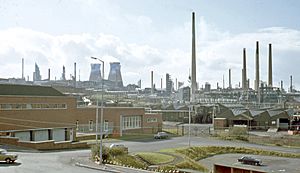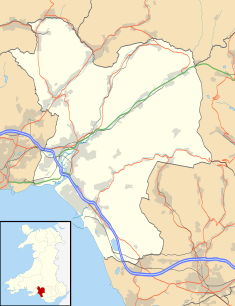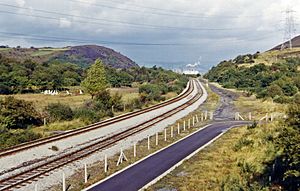Llandarcy Oil Refinery facts for kids

Refinery in 1973
|
|
| Country | UK |
|---|---|
| City | Swansea |
| Coordinates | 51°38′46″N 3°51′47″W / 51.646°N 3.863°W |
| Refinery details | |
| Operator | BP |
| Owner(s) | BP |
| Commissioned | 1919 |
| Decommissioned | 1998 |
| Capacity | 200,000 bbl/d (32,000 m3/d) |
| No. of employees | 2600 |
The Llandarcy Oil Refinery, also known as the National Oil Refinery or BP Llandarcy, was the very first oil refinery in the UK. It was opened by a company called the Anglo-Persian Oil Company on June 29, 1922. Before this, the only oil refined in the UK came from Scottish shale.
Contents
History of the Llandarcy Refinery
The Llandarcy Oil Refinery was a huge project. It cost about £3 million to build. The refinery eventually covered an area of about 400 hectares (that's like 1,000 acres!).
Construction started in February 1919. A new railway line was built to help with the construction. This railway helped move materials and products.
Opening and Naming
The refinery was officially opened by Stanley Baldwin. He was a very important person at the time, serving as the President of the Board of Trade. The refinery was named after William Knox D'Arcy. He was the person who founded the Anglo-Persian Oil Company.
Workers and Production
A special village was built near the refinery called Llandarcy. It was designed to house the refinery workers. In the 1950s, around 2,600 people worked there.
When it first opened, the refinery made about 150,000 gallons of petrol every day. By 1960, it was refining 8 million tons of crude oil each year. This made it the third largest oil refinery in the UK.
Closure of the Refinery
In 1961, a new oil terminal was built by BP in Pembrokeshire. The Llandarcy refinery eventually closed its doors in 1998. The entire site was taken down in October 2009.
How the Refinery Operated
When the refinery first started, it made petrol, kerosene, and fuel oils. By 1924, it was making many different oil products. These included lubricants, special oils, and paraffin wax. In 1926, they even added special units to break down oil using heat. These were called thermal cracking units.
In 1970, BP built a new section for making lubricating oil. This cost £16 million. It helped them make 100,000 tonnes of lubricating oil each year.
Oil Supply Pipeline
Crude oil was first brought to the refinery through Queen’s Dock in Swansea. But bigger ships were being built. So, a new terminal was constructed in 1962 at Angle Bay in Milford Haven. This new terminal could handle much larger oil tankers.
Crude oil was then pumped from Angle Bay to Llandarcy. This happened through a new pipeline that started working in November 1960. This pipeline was about 62 miles (96 km) long. It was 46 cm wide. The pipeline could carry 5 to 8 million tonnes of oil each year. It was used until 1985.
Final Years
In late 1985, half of the refinery's operations were stopped. The rest of it closed in January 1986. The refinery was then changed to be a specialist refinery. This means it focused on making specific types of oil products. It finally closed completely in 1999. The refinery was also a key part of the petrochemical industry in the area.
Location of the Refinery
The Llandarcy Oil Refinery covered a large area of 650 acres. It was located near the Llandarcy Interchange (Junction 43) of the M4. This area is known as Coedffranc. It was also close to the B4290 and Skewen.
See also
- BP Oil Refinery Ltd Ground
- National Oil Refineries/ BP Llandarcy - a football team linked to the refinery



